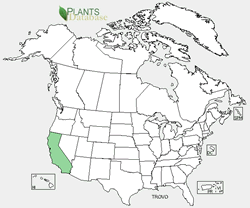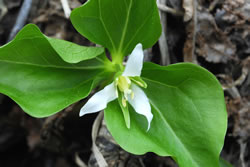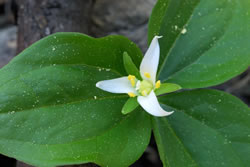Plant of the Week
 Trillium ovatum var. oettingeri range map. USDA PLANTS Database.
Trillium ovatum var. oettingeri range map. USDA PLANTS Database.
 Salmon Mountain wake robin (Trillium ovatum var. oettingeri). Photo by Ken DeCamp.
Salmon Mountain wake robin (Trillium ovatum var. oettingeri). Photo by Ken DeCamp.
 Salmon Mountain wake robin (Trillium ovatum var. oettingeri). Photo by Ken DeCamp.
Salmon Mountain wake robin (Trillium ovatum var. oettingeri). Photo by Ken DeCamp.
Salmon Mountain wake robin (Trillium ovatum var. oettingeri)
By Mark Pistrang
All trillium species belong to the Liliaceae (lily) family and are rhizomatous herbs with unbranched stems. Trillium plants produce no true leaves or stems above ground. The “stem” is actually just an extension of the horizontal rhizome and produces tiny, scale-like leaves (cataphylls). The above-ground plant is technically a flowering scape, and the leaf-like structures are actually bracts subtending the flower. Despite their morphological origins, the bracts have external and internal structure similar to that of a leaf, function in photosynthesis, and most authors refer to them as leaves.
Trilliums are generally divided into two major groups, the pedicellate and sessile trilliums. In the pedicellate trilliums, the flower sits upon a pedicel that extends from the whorl of bracts, either “erect” above the bracts, or “nodding” recurved under the bracts. In the sessile trilliums there is no pedicel and the flower appears to arise directly from the bracts.
While it is closely related cousin the western white trillium ranges up and down the Pacific coast, the Salmon Mountain wake robin is only known from selected sites in the mountains of northwestern California. Salmon Mountain wake robin falls within the pedicellate group of trilliums. Flowers are typically seen from May through July in coniferous and mixed coniferous-deciduous forests. Salmon Mountain wake robin can be differentiated from the related western white trillium by examining the bracts that subtend the flower. The bracts have short petioles in the Salmon Mountain variety, while the more common and wide ranging species has bracts that are sessile.
For More Information
- PLANTS Profile - Trillium ovatum var. oettingeri, Salmon Mountain wake robin
- Trillium in Flora of North America
- Reference: Case, F.W., R.B. Case. 1997. Trilliums. Timber Press, Portland, OR.

